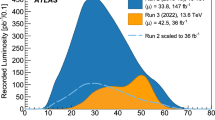Abstract
An experimental campaign aimed at studying various high spin phenomena using the Indian National Gamma Array (INGA) at the BARC–TIFR Pelletron Linac Facility has been successfully completed. The array consisting of a large number of Compton-suppressed clover detectors was coupled to a digital data acquisition system with 96 channels. The present system provides higher throughput, better energy resolution and better stability of gain for the multidetector Compton-suppressed clover array compared to its previous conventional system with analog shaping. Selected results from this array are discussed which highlight the exotic shapes, novel excitation modes and interesting isomers of the nuclei. The preliminary results from the experimental efforts to improve the sensitivity and capability of the array by adding ancillary detectors are also described briefly.









Similar content being viewed by others
References
I Y Lee, Nucl. Phys. A 520, 641c (1990)
J Simpson et al, Heavy Ion Phys. 11, 159 (2000)
S Frauendorf, Rev. Mod. Phys. 73, 463 (2001) J Meng and S Q Zhang, J. Phys. G: Nucl. Phys. 37, 064025 (2010)
B Cederwall et al, Nature 469, 68 (2011)
E A McCutchan et al, Phys. Rev. Lett. 103, 192501 (2009)
E Ideguchi et al, Phys. Rev. Lett. 87, 222501 (2001)
R K Bhowmik, Proceedings of Fourth International Conference on Fission and Properties of Neutron-Rich Nuclei p. 258 H C Jain, Pramana–J. Phys. 57(1) 21 (2001) S Muralithar et al, Nucl. Instrum. Methods A 622, p. 281 (2010) A K Sinha, Proceedings of DAE Symposium on Nuclear Physics 57, 66 (2012) R Palit, AIP Conf. Proc. 1336, 573 (2011)
S Saha et al, Proceedings of DAE Symposium on Nuclear Physics 58, 952 (2013)
R Palit, H C Jain, P K Joshi, S Nagaraj, B V T Rao, S N Chintalapudi and S S Ghugre, Pramana–J. Phys. 54, 347 (2000)
T Trivedi et al, Nucl. Phys. A 834, 72c (2010)
R Palit, H C Jain, P K Joshi, J A Sheikh and Y Sun, Phys. Rev. C 63, 024313 (2001)
S Lakshmi, H C Jain, P K Joshi, I Mazumdar, R Palit, A K Jain and S S Malik, Nucl. Phys. A 761, 12 (2005)
D Choudhury et al, Phys. Rev. C 82, 061308 (2010)
S Sihotra et al, Phys. Rev. C 78, 034313 (2008)
R Chakrabarti et al, Phys. Rev. C 80, 034326 (2009)
A Chakraborty et al, Phys. Rev. C 72, 054309 (2005)
R Palit et al, Nucl. Instrum. Methods Phys. Res. A 680, 90 (2012)
H Tan et al, Nuclear Science Symposium Conference Record (NSS 08) (IEEE, 2008) p. 3196
S Saha et al, Phys. Rev. C 86, 034315 (2012)
J Sethi et al, Phys. Lett. B 725, 85 (2013)
D Choudhury et al, Phys. Rev. C 87, 034304 (2013)
P Singh et al, Phys. Rev. C 85, 054311 (2012)
H Pai et al, Phys. Rev. C 85, 064313 (2012)
J Meng, J Peng, S Q Zhang and S G Zhou, Phys. Rev. C 73, 037303 (2006)
H L Liu, F R Xu, S W Xu, R Wyss and P M Walker, Phys. Rev. C 76, 034313 (2007)
P M Walker and J J Carroll, Phys. Today 58(6), 39 (2005)
D C Radford, Nucl. Instrum. Methods A 361, 306 (1995)
F R Espinoza-Quiñones et al, Phys. Rev. C 52, 104 (1995)
G H Bhat, J A Sheikh and R Palit, Phys. Lett. B 707, 250 (2012)
Acknowledgements
The author would like to thank the members of the INGA Principal Investigating Coordination Committee and the INGA Collaboration for making the detectors available. The contributions of Mr S Saha and Ms J Sethi in the present work are acknowledged. The author would also like to thank Prof. J A Sheikh and Mr G H Bhatt for the projected shell model calculations. The author also acknowledges the IUAC group for providing some of the HV units for the clover detectors. This work was partially funded by the Department of Science and Technology, Government of India (No. IR/S2/PF-03/2003-II). The author thanks the Pelletron and Linac staff for providing excellent beam during all experiments of the campaign.
Author information
Authors and Affiliations
Corresponding author
Rights and permissions
About this article
Cite this article
PALIT, R. Recent results from digital INGA at BARC–TIFR Pelletron Linac Facility and future plans. Pramana - J Phys 83, 719–728 (2014). https://doi.org/10.1007/s12043-014-0860-0
Published:
Issue Date:
DOI: https://doi.org/10.1007/s12043-014-0860-0




